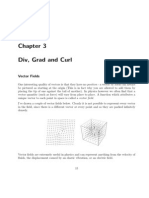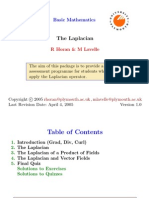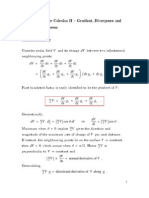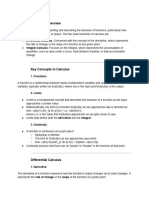0 ratings0% found this document useful (0 votes)
50 viewsAdvanced Calculus Lecture Notes - Multivariable Calculus
Uploaded by
FiuͥseͣnͫCopyright
© © All Rights Reserved
Available Formats
Download as PDF, TXT or read online on Scribd
0 ratings0% found this document useful (0 votes)
50 viewsAdvanced Calculus Lecture Notes - Multivariable Calculus
Uploaded by
FiuͥseͣnͫCopyright
© © All Rights Reserved
Available Formats
Download as PDF, TXT or read online on Scribd
You are on page 1/ 3
Topic: Divergence, Curl, and Laplacian in Vector Calculus
Gradient of a Scalar Field:
● For a scalar function f(x,y,z)f(x, y, z)f(x,y,z), the gradient ∇f\nabla f∇f is a vector field
pointing in the direction of the greatest rate of increase of fff.
● Definition: ∇f=(∂f∂x,∂f∂y,∂f∂z)\nabla f = \left( \frac{\partial f}{\partial x}, \frac{\partial
f}{\partial y}, \frac{\partial f}{\partial z} \right)∇f=(∂x∂f,∂y∂f,∂z∂f)
Divergence of a Vector Field:
● Measures the magnitude of a source or sink at a given point in a vector field.
● Definition: ∇⋅F=∂Fx∂x+∂Fy∂y+∂Fz∂z\nabla \cdot \mathbf{F} = \frac{\partial F_x}{\partial
x} + \frac{\partial F_y}{\partial y} + \frac{\partial F_z}{\partial z}∇⋅F=∂x∂Fx+∂y∂Fy+∂z∂Fz
● Physical Interpretation:
○ In fluid dynamics, divergence represents the rate at which density exits a point.
Curl of a Vector Field:
● Describes the rotation or swirling strength of a vector field at a point.
● Definition: ∇×F=(∂Fz∂y−∂Fy∂z,∂Fx∂z−∂Fz∂x,∂Fy∂x−∂Fx∂y)\nabla \times \mathbf{F} =
\left( \frac{\partial F_z}{\partial y} - \frac{\partial F_y}{\partial z}, \frac{\partial F_x}{\partial
z} - \frac{\partial F_z}{\partial x}, \frac{\partial F_y}{\partial x} - \frac{\partial F_x}{\partial y}
\right)∇×F=(∂y∂Fz−∂z∂Fy,∂z∂Fx−∂x∂Fz,∂x∂Fy−∂y∂Fx)
● Physical Interpretation:
○ In electromagnetism, curl relates to the rotation of the electric field.
Laplacian Operator:
● A scalar operator applied to scalar or vector fields.
● Definition (Scalar Field): ∇2f=∇⋅(∇f)=∂2f∂x2+∂2f∂y2+∂2f∂z2\nabla^2 f = \nabla \cdot
(\nabla f) = \frac{\partial^2 f}{\partial x^2} + \frac{\partial^2 f}{\partial y^2} + \frac{\partial^2
f}{\partial z^2}∇2f=∇⋅(∇f)=∂x2∂2f+∂y2∂2f+∂z2∂2f
● Applications:
○ Appears in Laplace's equation ∇2f=0\nabla^2 f = 0∇2f=0 and Poisson's
equation ∇2f=ρ\nabla^2 f = \rho∇2f=ρ.
Key Theorems:
1. Divergence Theorem (Gauss's Theorem):
○ Relates the flux of a vector field across a closed surface to the divergence over
the volume inside the surface.
○ Mathematical Statement: ∫V(∇⋅F)dV=∮∂VF⋅dA\int_V (\nabla \cdot \mathbf{F})
dV = \oint_{\partial V} \mathbf{F} \cdot d\mathbf{A}∫V(∇⋅F)dV=∮∂VF⋅dA
○ Implications:
■ Useful in electromagnetism for deriving Maxwell's equations.
2. Stokes' Theorem:
○ Connects the surface integral of the curl of a vector field over a surface to the line
integral around its boundary.
○ Mathematical Statement: ∫S(∇×F)⋅dS=∮∂SF⋅dr\int_S (\nabla \times
\mathbf{F}) \cdot d\mathbf{S} = \oint_{\partial S} \mathbf{F} \cdot
d\mathbf{r}∫S(∇×F)⋅dS=∮∂SF⋅dr
○ Implications:
■ Fundamental in fluid mechanics and electromagnetism.
Example Problem:
Compute the divergence and curl of the vector field F=(2xy,x2−z2,−2yz)\mathbf{F} = (2xy, x^2 -
z^2, -2yz)F=(2xy,x2−z2,−2yz).
Solution:
1. Divergence: ∇⋅F=∂∂x(2xy)+∂∂y(x2−z2)+∂∂z(−2yz)\nabla \cdot \mathbf{F} =
\frac{\partial}{\partial x}(2xy) + \frac{\partial}{\partial y}(x^2 - z^2) + \frac{\partial}{\partial
z}(-2yz)∇⋅F=∂x∂(2xy)+∂y∂(x2−z2)+∂z∂(−2yz) =2y+0−2y=0= 2y + 0 - 2y = 0=2y+0−2y=0
2. Curl: ∇×F=∣ijk∂∂x∂∂y∂∂z2xyx2−z2−2yz∣\nabla \times \mathbf{F} = \left|
\begin{array}{ccc} \mathbf{i} & \mathbf{j} & \mathbf{k} \\ \frac{\partial}{\partial x} &
\frac{\partial}{\partial y} & \frac{\partial}{\partial z} \\ 2xy & x^2 - z^2 & -2yz \end{array}
\right|∇×F=i∂x∂2xyj∂y∂x2−z2k∂z∂−2yzCompute each component:
○ (∇×F)x=∂∂y(−2yz)−∂∂z(x2−z2)=−2z−(−2z)=0(\nabla \times \mathbf{F})_x =
\frac{\partial}{\partial y}(-2yz) - \frac{\partial}{\partial z}(x^2 - z^2) = -2z - (-2z) =
0(∇×F)x=∂y∂(−2yz)−∂z∂(x2−z2)=−2z−(−2z)=0
○ (∇×F)y=∂∂z(2xy)−∂∂x(−2yz)=0−(−2y)=2y(\nabla \times \mathbf{F})_y =
\frac{\partial}{\partial z}(2xy) - \frac{\partial}{\partial x}(-2yz) = 0 - (-2y) =
2y(∇×F)y=∂z∂(2xy)−∂x∂(−2yz)=0−(−2y)=2y
○ (∇×F)z=∂∂x(x2−z2)−∂∂y(2xy)=2x−2x=0(\nabla \times \mathbf{F})_z =
\frac{\partial}{\partial x}(x^2 - z^2) - \frac{\partial}{\partial y}(2xy) = 2x - 2x =
0(∇×F)z=∂x∂(x2−z2)−∂y∂(2xy)=2x−2x=0
○ Result: ∇×F=(0,2y,0)\nabla \times \mathbf{F} = (0, 2y, 0)∇×F=(0,2y,0)
Interpretation:
● The divergence is zero, indicating an incompressible field.
● The curl has a non-zero component in the yyy-direction, indicating rotation about the
yyy-axis.
Additional Notes:
● Orthogonal Coordinate Systems:
○ Be familiar with expressions of divergence and curl in cylindrical and spherical
coordinates.
● Applications:
○ These operators are crucial in physics, particularly in Maxwell's equations for
electromagnetism.
Assignments:
● Reading: Sections 5.6-5.8 in the textbook.
● Problems:
○ Compute divergence and curl for given vector fields in different coordinate
systems.
○ Prove the vector calculus identities listed in Appendix A.
●
You might also like
- 471 - Instructions FIDY8BW9 FIDY8BW9-SHPR F1DY8G59 F1DY8G59-SHPR F1DY81G9 F1DY8009 Renew-Led-Desk-LampNo ratings yet471 - Instructions FIDY8BW9 FIDY8BW9-SHPR F1DY8G59 F1DY8G59-SHPR F1DY81G9 F1DY8009 Renew-Led-Desk-Lamp1 page
- Download full Calculus 6th Edition Karl J. Smith ebook all chapters100% (13)Download full Calculus 6th Edition Karl J. Smith ebook all chapters75 pages
- Calculus 6th Edition Karl J. Smith instant download100% (2)Calculus 6th Edition Karl J. Smith instant download51 pages
- (Ebook) Calculus by Karl J. Smith, Magdalena Daniele Toda, Monty J. Strauss ISBN 9781465229236, 146522923X All Chapters Instant Download100% (2)(Ebook) Calculus by Karl J. Smith, Magdalena Daniele Toda, Monty J. Strauss ISBN 9781465229236, 146522923X All Chapters Instant Download67 pages
- The Wave Equation in Cylindrical CoordinatesNo ratings yetThe Wave Equation in Cylindrical Coordinates6 pages
- Divergence and Curl of A Vector Function: ObjectivesNo ratings yetDivergence and Curl of A Vector Function: Objectives13 pages
- A Linearization: A.1 Functions of One VariableNo ratings yetA Linearization: A.1 Functions of One Variable8 pages
- Mary L Boas Edisi 3 Bab5 Integral PermukaanNo ratings yetMary L Boas Edisi 3 Bab5 Integral Permukaan7 pages
- 20.3 The Curl of A Vector Field: N Area (D) 0 CNo ratings yet20.3 The Curl of A Vector Field: N Area (D) 0 C2 pages
- Vector Operators: Vector Dot Product: VectorNo ratings yetVector Operators: Vector Dot Product: Vector10 pages
- PH-801: Important Formula: Cartesian Coordinate SystemNo ratings yetPH-801: Important Formula: Cartesian Coordinate System2 pages
- Electromagnetic Waves in Vacuum: Maxwell's Equations in Free SpaceNo ratings yetElectromagnetic Waves in Vacuum: Maxwell's Equations in Free Space6 pages
- Calc 3 Lecture Notes Section 12.3 1 of 6No ratings yetCalc 3 Lecture Notes Section 12.3 1 of 66 pages
- DC DC Converter, Relay Drive and Motor Drive Applications: Absolute Maximum RatingsNo ratings yetDC DC Converter, Relay Drive and Motor Drive Applications: Absolute Maximum Ratings6 pages
- 2015-Soares Et Al-Cost Allocation Model For Distribution Networks Considering High Penetration of Distributed Energy ResourcesNo ratings yet2015-Soares Et Al-Cost Allocation Model For Distribution Networks Considering High Penetration of Distributed Energy Resources13 pages
- Beamex Ebook Calibration Essentials PressureNo ratings yetBeamex Ebook Calibration Essentials Pressure40 pages
- Transistor Characteristics Theory SupportNo ratings yetTransistor Characteristics Theory Support70 pages
- Norma ASTM D2166Standard Test Method For Unconfined Compressive Strength of Cohesive SoilNo ratings yetNorma ASTM D2166Standard Test Method For Unconfined Compressive Strength of Cohesive Soil6 pages
- Module 3 - Switched Reluctance Motor Noices.No ratings yetModule 3 - Switched Reluctance Motor Noices.2 pages
- Danfoss Scroll Compressors: SM - Sy - SZNo ratings yetDanfoss Scroll Compressors: SM - Sy - SZ56 pages
- Product Certification and Declaration of ConformityNo ratings yetProduct Certification and Declaration of Conformity1 page
- Chapter-04-Applications-Thermodynamics-Earth 4744 0 PDFNo ratings yetChapter-04-Applications-Thermodynamics-Earth 4744 0 PDF43 pages
- Collins Edexcel Maths Higher Scheme of Work - 3 YearNo ratings yetCollins Edexcel Maths Higher Scheme of Work - 3 Year19 pages
- Geophysical Research Letters - 2011 - KrevorNo ratings yetGeophysical Research Letters - 2011 - Krevor5 pages

























































































